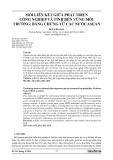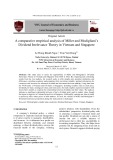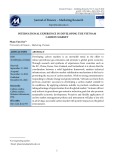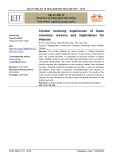
23
Journal of Development and Integration, No. 79 (2024)
No. 79 (2024) 23-31 I jdi.uef.edu.vn
K E Y W O R D S A B S T R A C T
Exchange rate volatility,
Vietnam’s export
values,
G7 countries,
Gravity model for trade,
Vietnam-G7
trade relations.
The recruitment of highly experienced professionals is a crucial undertaking as it creates
the talent pool for the organisation. Although the development and implementation of
electronic recruiting applications in MNCs have been highly effective, they not only
contribute to reducing candidate screening time but also effectively support employer’s
productivity. In other words, E-HRM is the practice of integrating HRM strategies, policies,
and practices in a company through the use of web-based technology. Yet, the raising
concern is how organisations in Vietnam could effectively learn and utilise e-recruitment
since most companies continue to employ manually with pricey recruitment methods.
The study aims to identify the fundamental concept of e-recruitment and intends to collect
information regarding e-recruitment methods such as emails, corporate websites, and
commercial job boards, among others, through the story of AkzoNobel, Unilever and
Cathay Pacific in installing the e-recruitment system in Vietnam and in ASEAN. It covers
the advantages and disadvantages of e-recruitment, as well as how local Vietnamese
businesses might efficiently use it.
* Corresponding author. Email: nttnguyen@ttn.edu.vn
https://doi.org/10.61602/jdi.2024.79.03
Received: 23-May-24; Revised: 29-Aug-24; Accepted: 06-Sep-24; Online: 30-Oct-24
ISSN (print): 1859-428X, ISSN (online): 2815-6234
Nguyen Trinh Thanh Nguyen*
Tay Nguyen University, Vietnam
The role of exchange rates in Vietnam’s
export values to G7 countries
1. Introduction
The nexus between the G7 comprising the United
States, Canada, the United Kingdom, Germany, France,
Italy, Japan, and Vietnam has witnessed a persistent
evolution over recent years. This progression has been
underscored by an escalating synergy across diverse
domains, with a particular emphasis on trade relations.
It is worth noting that Japan, the United States, and
Germany emerged as pivotal trading counterparts
for Vietnam, both within the G7 cohort and more
broadly. Of noteworthy significance is the trade
equilibrium between Vietnam and G7 member states,
which holds substantial promise for robust growth.
This optimism stems from Vietnam’s formalization
of innovative trade accords with G7 nations, such as
the European Union-Vietnam Free Trade Agreement
(EVFTA) and the Trans-Pacific Partnership (TTP).
These accords are poised to usher in a new era of
economic collaboration between Vietnam and the G7,
further enhancing their economic interdependence
and fostering mutually beneficial outcomes (Ministry

24 Journal of Development and Integration, No. 79 (2024)
of Industry and Trade of Vietnam, 2022). According
to the 2022 data from the General Department
of Customs, the total import-export turnover of
Vietnamese enterprises to the markets of G7 member
countries exceeded $209 billion, marking an 11.6%
increase (equivalent to a $21.8 billion absolute
increase) compared to 2021. Specifically, the total
value of goods exported by Vietnamese businesses
to G7 member countries reached $163.16 billion,
reflecting a 15.7% growth compared to 2021 and
constituting nearly half of the nation’s overall export
value to all global markets. Over an extended period
spanning from 2007 to 2021, Vietnam’s exports of
goods and services to G7 countries have exhibited
remarkable growth, surging nearly twentyfold from
$8.52 billion in 2007 to $168.69 billion in 2021
(comprehensive data sourced from the Ministry of
Industry and Trade of Vietnam and the International
Trade Center-ITC). As of the end of 2023, according
to the General Department of Vietnam Customs, the
total bilateral trade between Vietnam and the United
States reached $110.8 billion, a decrease of 10.5%
compared to 2022, with Vietnam’s exports reaching
$97.0 billion and imports from the U.S. totaling
$13.8 billion. Trade between Vietnam and the United
Kingdom surpassed $7.1 billion, an increase of 4.5%,
with Vietnam’s trade surplus exceeding $5.5 billion.
Vietnam’s exports to Canada reached approximately
$5.6 billion, a decrease of 11.3%, but showed signs
of recovery since September 2023. Trade with
Japan totaled $45 billion, a decrease of 5.6%, with
Vietnam’s exports at $23.3 billion and imports from
Japan at $21.6 billion. Trade with Germany saw a
17.5% decrease in exports, while imports increased
by 2.1%. Exports to Italy increased by 1.0%, but
imports decreased by about 9%. Exports to France
decreased by 14.2%, while imports remained
relatively unchanged compared to 2022.
Nonetheless, Vietnam’s export relations with the
G7 group also confront several challenges, including
intense competition from advanced economies within
the G7, stringent regulations concerning quality
and technical standards, as well as trade policies,
particularly exchange rate management policies and
exchange rate fluctuations, which can impact the
scale and scope of exports (Nga, 2021).
The G7 group comprises nations representing
major currencies (the US dollar, the Euro, the Japanese
yen, and the British pound) with a significant role in
global trade. Research has shown that exchange rates
directly impact the value of imports and exports,
foreign capital inflows, and indirectly influence
the entire economy (Thao et al., 2022). Given that
Vietnam is a developing country, most of its trade
transactions with the majority of its partners are
conducted using strong currencies from the G7 group.
Nevertheless, the values of these currencies from G7
nations have exhibited frequent fluctuations in recent
years, exerting notable effects on Vietnam’s import
and export activities (Tram et al., 2017). Hence, this
study aims to contribute to the assessment of the
impact of exchange rate fluctuations of the Vietnamese
Dong (VND) and the currencies of G7 nations during
the period from 2007 to 2021 on the export value of
Vietnam to G7 countries. Additionally, by employing
the Gravity Model for Trade, this research addresses
the effects of various economic factors on Vietnam’s
export performance to G7 nations. Consequently, it
offers recommendations to enhance trade relations,
especially Vietnam’s export activities with G7
nations.
In summary, using publicly available data,
statistical methods, and a quantitative model, this
article analyzes and assesses the interrelationship
between exchange rate fluctuations and Vietnam’s
export value to G7 countries during the 2007-2021
period. Moreover, the study utilizes and customizes
the “Gravity Model for Trade” to examine the effects
of exchange rate volatility on Vietnam’s export values
to the G7 nations.
2. Literature review
The objective of Vietnam’s exchange rate policy
is to control inflation, stabilize the macroeconomy,
maintain a reasonable and sustainable economic
growth rate, encourage exports, improve the
international balance of payments, and increase
foreign exchange reserves. To achieve these goals,
Vietnam has employed various exchange rate
management tools, including exchange rate bands,
discount rate adjustments, required reserve ratio
adjustments, foreign exchange operations, tight
management of the foreign exchange market, and
efforts to reduce dollarization. Notably, in the context
of an increasingly open economy that is sensitive to
global fluctuations, Vietnam has made significant
changes in determining the official exchange rate,
shifting from the interbank exchange rate to the
central rate (Huong, 2021).
Nguyen Trinh Thanh Nguyen

25
Journal of Development and Integration, No. 79 (2024)
Anh (2021) examined Vietnam’s exchange rate
policy from 2008 to 2020, proposing enhancements
to improve the country’s export and import situation.
The study calculated the Real Effective Exchange
Rate (REER) with ten major trading partners, rather
than relying solely on the VND/USD exchange rate.
The findings showed that the real exchange rate
negatively impacts the trade balance in the short term,
but influences it overall. Similarly, Vinh and Duong
(2019) used the ARDL bounds testing approach to
analyze exchange rate volatility’s impact on Vietnam’s
exports from 2000 to 2014. Their results indicated
that exchange rate volatility negatively affects export
volumes in the long term, with currency depreciation
having a short-term adverse impact but a positive
long-term effect on exports.
However, Nga’s study (2021) presented results
that indicated an opposite direction of influence (a
positive effect) of the exchange rate on Vietnam’s
export values. In this study, the multilateral real
exchange rate (VND) was calculated quarterly
from Q1 2000 to Q2 2019, based on a currency
basket comprising 16 currencies of Vietnam’s 18
major trading partners, accounting for up to 80% of
Vietnam’s total import-export value. The quantitative
findings revealed that exchange rate fluctuations had
a positive impact on export values but did not exhibit
a clear influence on Vietnam’s import values. Cai
(2021) analyzed data from 1995 to 2020, finding that
import and export activities significantly impacted the
exchange rate. Exports and imports moved similarly
with the exchange rate individually, but exports
moved inversely while imports moved directly with
the exchange rate simultaneously. The study’s model
showed a substantial impact of trade activities on the
exchange rate.
Quantitative results showed that in the short
term when exchange rate shocks occurred, exports
were consistently adjusted towards equilibrium in
the long term. However, in the long term, exchange
rate fluctuations and export commodity prices
had a negative impact on the growth of Vietnam’s
exports. Baek (2013) has pointed out that research
on the relationship between exchange rates and trade
relationships typically adopts three different data
methodologies: the first method relies on aggregate
trade data, including data on exports and imports for
the entire economy; the second method uses bilateral
aggregate trade data; and the third method examines
trade data at the industry level. Accordingly, studies
on the impact of exchange rates on trade relationships
between Vietnam and its trading partners have been
conducted using these various approaches. Among
these, Bao and Le (2021) examined the effects of
the real exchange rate on the trade balance between
Vietnam and 16 trading partners from the European
Union and the United Kingdom from 1999 to 2012.
This study investigated the long-term relationship
between the real exchange rate, trade balance,
domestic income, and foreign income between
Vietnam and its trading partners in the research
model. The research results indicated that the real
exchange rate and domestic income had a negative
impact on Vietnam’s trade balance with its trading
partners.
Baek and Yoon (2023) concentrated on the trade
relationship between South Korea and Vietnam
and the impact of the bilateral exchange rate on
this relationship. The research demonstrated that
the exchange rate significantly influenced South
Korea’s exports to Vietnam. However, the impact of
the exchange rate on Vietnam’s imports from South
Korea was not significant. The asymmetric impact of
the exchange rate on the bilateral trade relationship
between Vietnam and South Korea could be explained
by various factors such as competitiveness and import
dependence.
Ho et al. (2021) examined the asymmetric and
symmetric impacts of the real exchange rate on the
bilateral trade value between the United States and
Vietnam at the industry level. The authors concluded
that (i) only the symmetric real exchange rate was
statistically significant in explaining the overall trade
balance between the United States and Vietnam in
the long term, with a 10% statistical significance;
(ii) the industry-level impacts were heterogeneous
and depended on the type of goods; and (iii) both
asymmetric impacts were found in both the short
and long term in 29 industries, accounting for 69%
of the total industrial types between Vietnam and the
United States.
Similarly, Tran (2019) evaluated the impact of
exchange rates on the trade flows between Vietnam
and Japan using industry-level data. The research
findings indicated that the trade value of each
industry exhibited different reactions to exchange rate
fluctuations, with asymmetric responses found in 9 out
of 16 industries affected by changes in the exchange
rate. The model using aggregate data showed that the
exchange rate had a positive impact on the overall
Nguyen Trinh Thanh Nguyen

26 Journal of Development and Integration, No. 79 (2024)
trade balance between Vietnam and Japan in the case
of currency depreciation. Additionally, the results of
this study also showed that Japan’s economic activity
had a positive impact on the trade relationship
between Vietnam and Japan.
When examining another significant trade partner
for Vietnam, namely China, the research conducted
by Anh et al. (2019) quantified the impact of the
exchange rate between Vietnam and China (VND/
CNY, including both the level and volatility of the
exchange rate) on the trade flow value between
Vietnam and China. The quantitative results showed
that, in the long term, nine imported commodities of
Vietnam (constituting about 28.67% of total imports)
were sensitive to changes in the level of the real
exchange rate, and nine exported commodities to
China (accounting for approximately 39.15% of total
exports) also responded to changes in the level of the
exchange rate.
While there are variations in the findings of the
aforementioned studies, they all underscore the
impact of exchange rates on bilateral trade and its
potential variations by sector or trade partner. These
studies serve as just a few examples of the influence of
exchange rates on Vietnam’s trade values, particularly
in terms of export turnover. Additionally, numerous
other research endeavors have been conducted in
various countries and regions worldwide to delve
deeper into the relationship between exchange rates
and trade balances, as well as export and import
values, across different scales.
3. Research methodology and specific model
3.1. Research methodology
The article employs a combination of various
methods, including desk research, statistics,
analysis, and data synthesis, using both primary and
secondary sources. Secondary data is collected from
sources such as the World Bank (WB) database, the
International Trade Center (ITC) database, and the
General Statistics Office of Vietnam (GSO), among
others. The research is built upon qualitative and
quantitative studies conducted both domestically and
internationally, examining the impact of exchange
rates on trade and export values in Vietnam. The
study employs the “Gravity Model for Trade” to
construct and assess the relationship between export
values and exchange rate fluctuations in Vietnam
with each country in the G7 group from 2007 to
2021. The model aims to determine the direction
of the exchange rate’s impact on Vietnam’s export
values to G7 countries. Based on the research
findings, the author provides policy implications to
enhance the effectiveness of Vietnam’s exchange rate
management, ultimately increasing export values to
G7 countries. The estimations in this research model
are performed using Stata software.
3.2. Research Model
3.2.1. An introduction to the “Gravity Model for
Trade”
In recent years, the “Gravity Model for Trade”
has become widely used to analyze the trends and
outcomes of international trade activities. Tenbergen
(1962) can be considered the pioneer in applying
the law of universal gravitation to the analysis of
international trade flows (similar to Newton’s law of
universal gravitation). This model has been applied
and developed by researchers to quantify bilateral
trade flows between economies. The fundamental
principle of the model is that bilateral trade
relationships depend on the size of two economies
and the distance between them. The general model is
constructed as follows (Krugman & Maurice, 2005):
LnT
i j =α 0 + α 1 lnYi+ α 2 lnYj+ α 3 lnDij+ α 4 lnRij+ α 5 lnπij
+ e i j , (1)
In which:
Tij Total trade value (total trade) between country
i and country j; Yi, Yj: Total gross domestic product
(GDP) of country i; total GDP of country j; Dij: The
distance between i and j (usually measured as the
distance between the capitals of the two countries).
The correlation coefficient β represents the
degree of influence of each factor on bilateral trade
volume (for example, if the total domestic product
of country j increases by 1%, exports will increase
by β%). Hence, at its core, this model serves as a
comprehensive tool for dissecting the intricate web of
influences shaping global trade flows. It encompasses
an array of factors, both positive and negative in
character, that intricately define trade patterns. These
affirmative factors include the economic dimensions
of a nation, such as GDP, GNP, and per capita income.
The underlying expectation is that countries boasting
higher income levels and robust growth trajectories
exhibit an inclination to enhance their trade activities,
Nguyen Trinh Thanh Nguyen

27
Journal of Development and Integration, No. 79 (2024)
while their counterparts may experience reduced
trade participation.
Conversely, the model acknowledges the
adverse influences of negative factors, primarily
the geographical distance that separates trading
economies. This distance factor has direct implications
for cost considerations, transportation durations,
and various ancillary trade-related expenditures.
Economic scholars have further extended the model’s
utility by encompassing a broader spectrum of
influencing variables. This expansion encompasses
the incorporation of population size and development
assistance, serving as proxies for the economic scale,
alongside the consideration of tariffs – encompassing
export and import levies – which pose impediments
to international trade interactions between nations.
The dataset is structured in the form of panel
data, encompassing multiple dimensions. It includes
variables such as export values, GDP, per capita
income, exchange rates, and direct foreign investments
for Vietnam and seven G7 countries, spanning the
period from 2007 to 2021. Additionally, the dataset
contains information on the geopolitical influence of
Vietnam with respect to G7 member nations and the
geographical distances between Vietnam and these
G7 countries.
The choice of the study’s start year in 2007 is
due to Vietnam’s accession to the World Trade
Organization (WTO). Furthermore, due to data
unavailability for the year 2022, the study collects
data up to 2021. Data on Vietnam’s export values to
G7 countries are annual figures, denominated in US
dollars, sourced from the General Statistics Office
and the International Trade Centre database. The
Gross Domestic Product (GDP) of Vietnam and G7
countries within the period t serves as an indicator of
the economic scale. This variable is expected to have
a significant and positive correlation with Vietnam’s
export values. The per capita income of G7 countries
and Vietnam is obtained from the World Bank
database. These values are converted into current US
dollars and further adjusted to constant US dollars of
the year 2010 using the GDP deflator index provided
by the World Bank.
Exchange rate data for Vietnam and G7 countries
is extracted from the databases of the Organization for
Economic Co-operation and Development (OECD),
the World Bank, and the State Bank of Vietnam.
The anticipated impact of the real exchange rate
variable on Vietnam’s export values to G7 countries
is negative. Distance is included in the analysis to
represent transportation costs between Vietnam
and G7, calculated as the distance between Hanoi,
Vietnam’s capital, and the capital cities of the G7
nations. Distance data is derived from the great circle
distance between capital cities, measured along the
Earth’s surface and sourced online from Chemical-
ecology.net. This variable is expected to have a
negative impact on trade, as transportation costs tend
to rise with increased distance between countries.
The Polipower index, calculated as a weighted
index of the Environmental Performance Index (EPI),
is used to capture global effects on trade. Economic
freedom index data is sourced from The Heritage
Foundation (http://www.heritage.org/index). The
FDI variable represents the foreign direct investment
value of G7 countries into Vietnam, collected from
the databases of the General Statistics Office of
Vietnam and the ITC. Additional dummy variables,
such as borders, languages, colonial history, and
trade agreements, may be introduced into the
gravity equation to investigate qualitative variables
influencing bilateral trade. These dummy variables
are considered to enhance the robustness of estimation
Variable Obs Mean Std. Dev. Min Max
Exoprt vnj 105 10914030 16536543 708727 1.082e+08
GDPvn 105 2.334e+11 6.009e+10 1.496e+11 3.311e+11
GDPj 105 4.900e+12 5.430e+12 1.358e+12 2.034e+13
INCOMEvn 105 2520.26 541.18 1751.708 3373.083
INCOMEj 105 40971.452 7814.22 29358.129 61280.39
DISij 105 9245 2847.103 3865 13789
ExRateij 105 20888.088 9511.917 136.77 34798.369
PoliPowerij 105 .96 .553 .561 2.415
FDIj vn 105 918.75 1977.901 4.53 9945.09
Table 1. Descriptive Statistics of Model Variables
Nguyen Trinh Thanh Nguyen


























